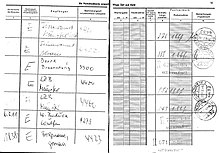Consignment slip
Postage certificates are issued ex officio by the postal service for the delivery of a value and registered mail , for parcels , for normal cash on delivery items and for cash payments such as postal orders or payment cards and , if requested, for normal parcels.
Consignment slip
Consignment certificates existed as early as the 18th century due to a wide variety of regulations and in a wide variety of forms. More uniform was the requirement to charge a bill for such receipts, which the sender had to pay. This bogus money was abolished everywhere in the middle of the 19th century, if it was not a question of consignments for which a certificate was only issued on request, e.g. B. for ordinary packages.
In the case of domestic postal orders and payment cards, a section of the form serves as evidence, other items to be verified are certified on a loose form. Larger consignors of such consignments could have their posting certified in a “postal posting book”.
The posting certificate is a public document in the sense of § 415 ZPO and proves the posting of the shipment to the post office. In the event of loss of such a consignment to be verified, the replacement amount will be paid upon presentation of the posting certificate.
See also
- Post's liability to pay compensation, Post's liability for mail and in the postal service.
- Letters , inquiries about the whereabouts of mail.
Web links


